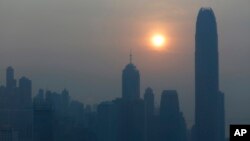Despite a noticeable drop in Hong Kong’s real estate market, some areas of the city are still experiencing a boom because of gentrification.
Hong Kong real estate prices are projected to fall 20 percent by the end of 2017. But in recent years, several of the city’s oldest working-class neighborhoods have quickly been transformed by real estate developers to become trendy new districts populated with cafes, boutiques and new homes for wealthy locals and foreign nationals.
Residents like Alex Lau say the development has contributed to widespread discontent over the gap between rich and poor.
“The Hong Kong government always helps the developers of the land too much, and some people cannot even have a simple house. That is the main problem,” he said.
Sheung Wan, Sai Ying Pun, Tai Hang and Kennedy Town have all gradually changed into popular, hip neighborhoods, drawing the city’s fashionable elite, causing rents to increase.
Kowloon’s waterfront is being developed into a new culture and arts district, and the neighborhood of Sham Shui Po, one of the poorest in Hong Kong, is increasingly becoming a haven for the city’s entrepreneurs, designers and artists.
Art as attraction
Last month, arts organization HKWalls staged a festival in the neighborhood, drawing international and local artists to paint murals there.
Jason Dembski, co-founder of HKWalls, said he wants to make a positive difference in neighborhoods like Sham Shui Po and that art benefits every person, no matter their socio-economic class.
“I think art’s good for everyone, regardless of stature," he said. "I don’t think it’s elitist at all. It certainly can be. There are people who think one way about art, but in general I think art should be available to everyone.”
But critics say the arts festival represents the beginning of a transformation experienced by other Hong Kong districts, where high brow art and fashion replace everyday commerce, and the wealthy gradually edge out the poor.
“As far as I am concerned I don’t think they have any other places to go if the prices of Sham Shui Po rise up," said Ahkok Wong, a culture critic and lecturer at Lingnan University. "But that’s exactly what we are looking at right now: the old Chinese restaurants are closing down, and the fancy restaurants, the Italian cafes, are moving in. You can see a lot of murals painted there, so everything is changing really, really fast.”
A community group in Sham Shui Po says nearly 7,000 residents have been displaced and 187 buildings demolished in the district since 2001, when it was home to the city’s garment industry.
The neighborhood, like many others in Hong Kong, will continue to transform. Developers are planning to build a 150-bed luxury hotel there, with a pool and bar, that will open in three to four years’ time.








